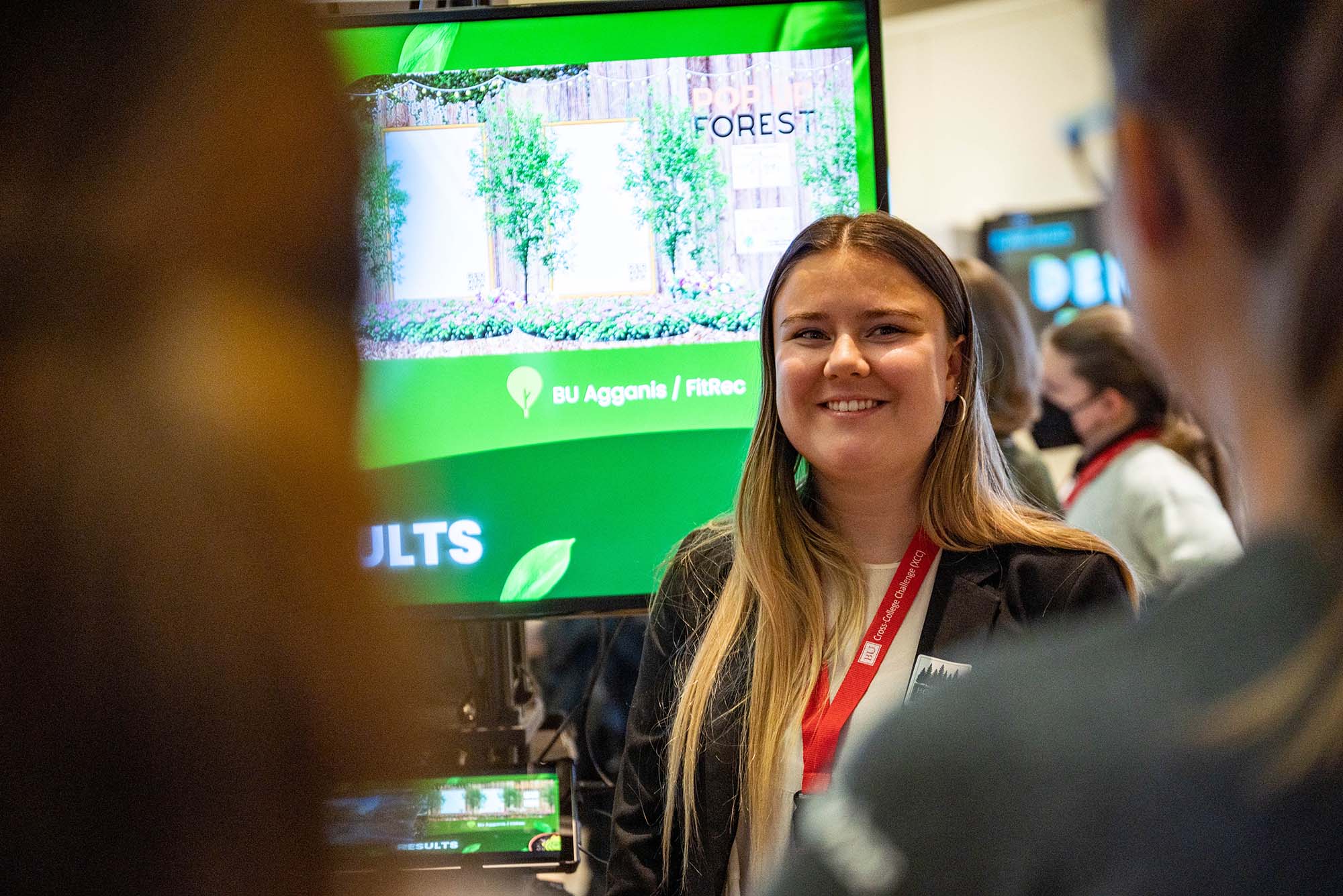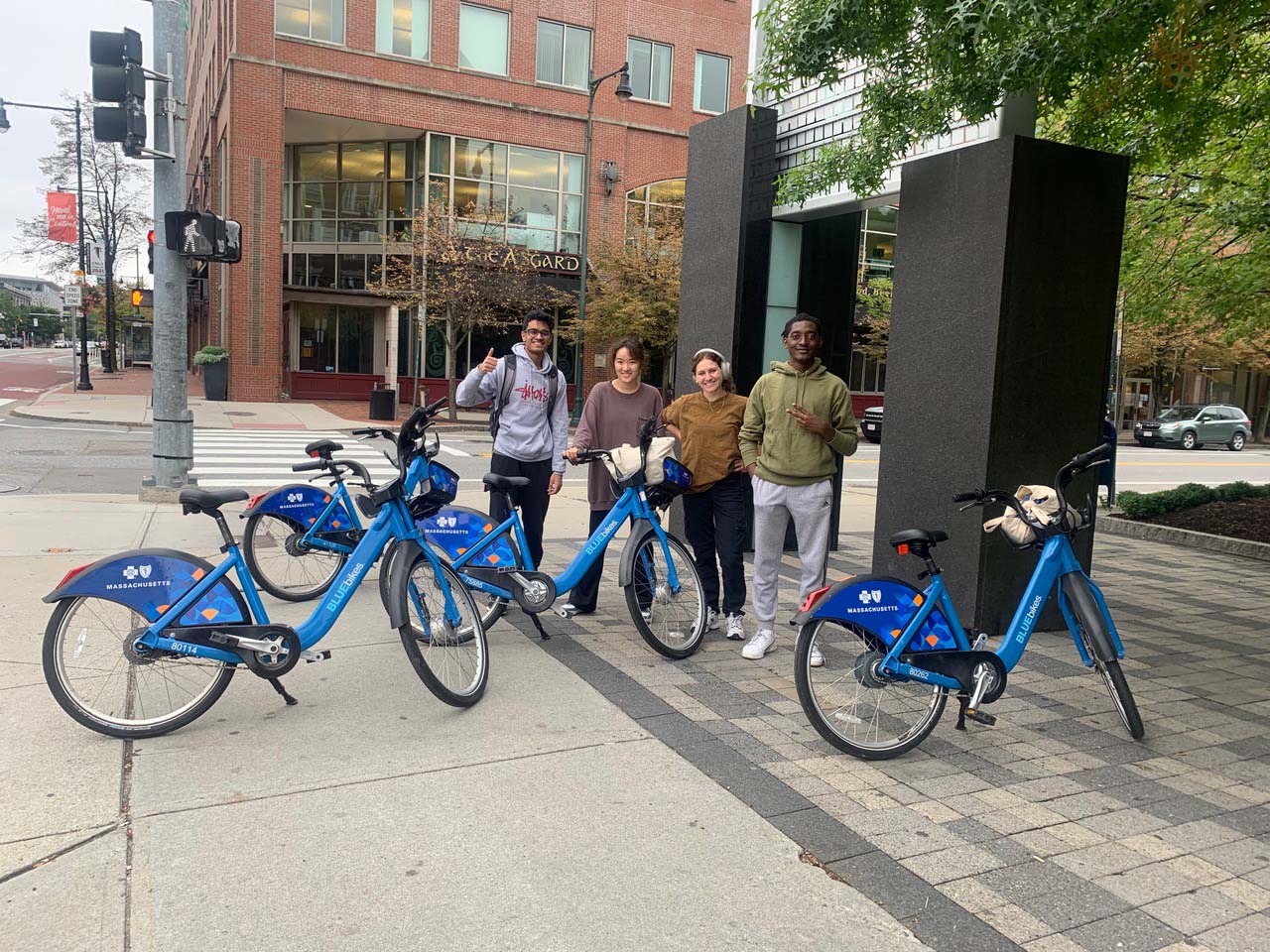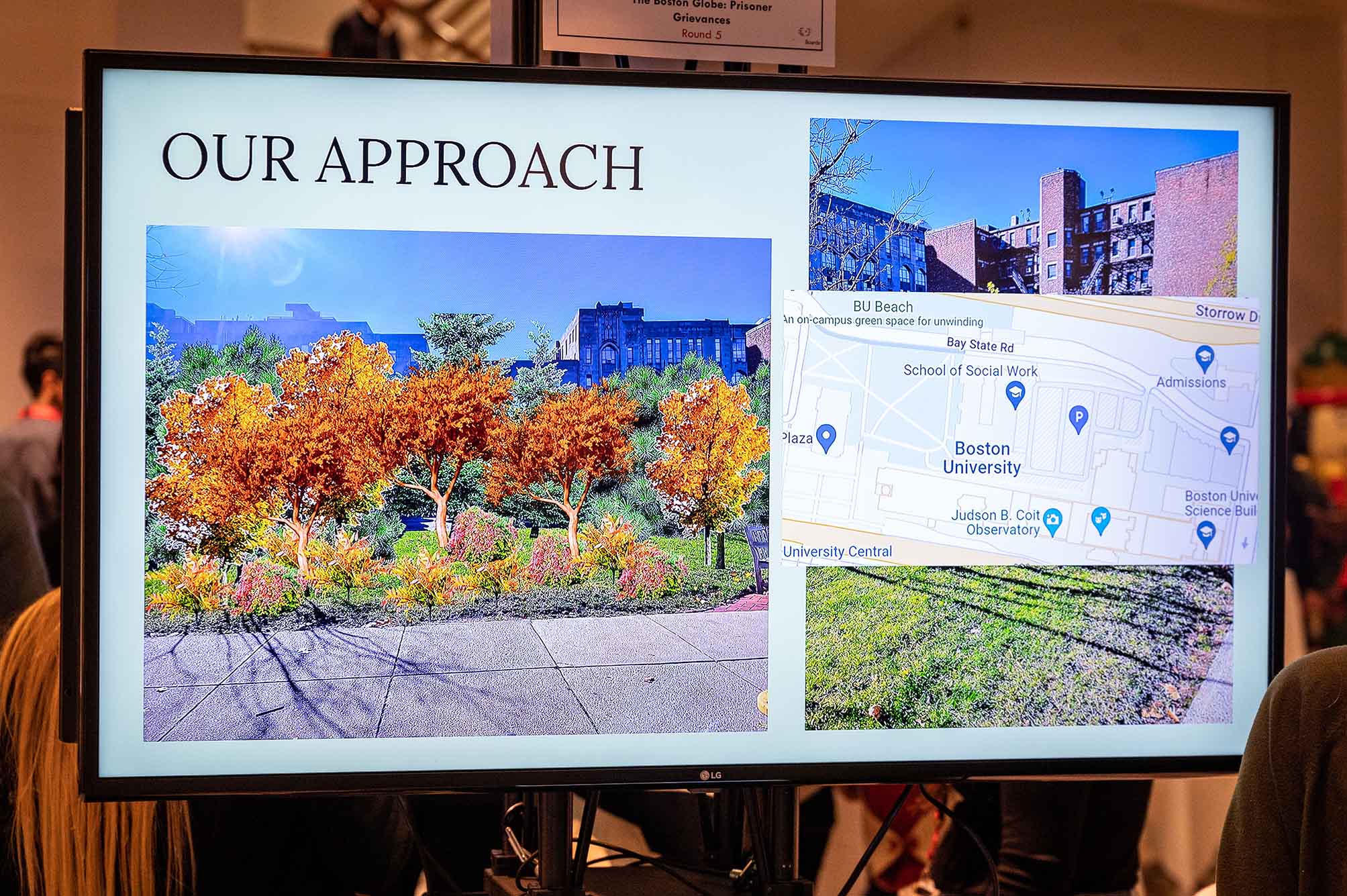A Tree Grows in Boston
XCC course wants students to challenge environmental injustice by improving the urban tree canopy

Emily Burbo (COM’24) presenting a slide in her pop-up forest team’s final presentation at the December 13 XCC event at the Questrom School of Business. Photo by Andrew Burke-Stevenson (COM’26)
A Tree Grows in Boston
XCC course wants students to challenge environmental injustice by improving the urban tree canopy
Tucked in a corner of Danehy Park in North Cambridge is a 4,000-square-foot ring densely packed with tender saplings. While it looks like a bizarre community garden plot or a tiny rainforest, it’s actually an effective tool in the fight against urban heat island effect: a Miyawaki forest.
Inspired by the afforestation techniques of pioneering botanist Akira Miyawaki, a Miyawaki forest is an array of biodiverse indigenous plants in dense proximity to one another. Since the concept’s introduction in India by Miyawaki devotee and afforestation pioneer Shubhendu Sharma, it has been adopted globally to mitigate climate change effects such as rising temperatures and flood levels. The Miyawaki forest in Danehy Park was installed in 2019, and last month the city of Cambridge planted a second one in Greene-Rose Heritage Park.
The work required to install a Miyawaki forest or its analogue, the pop-up forest (a smaller, temporary installation that often includes more mature trees) requires lots of planning. Prior to installation, environmental research and site surveys must be conducted, funds raised to support the project, necessary approvals secured, and volunteers lined up to help with the planting.

It’s not an easy task, which is why Joelle Renstrom, a College of General Studies senior lecturer in rhetoric, and Salvatore Genovese, a CGS lecturer in natural sciences and mathematics, want to shepherd students through the process of creating impactful, community-driven projects to combat climate change. HUB XC 433: Environmental Equality and Urban Tree Canopies is a BU Hub Cross-College Challenge (XCC) course designed to give students an integrated understanding of ecology, environmental equity, and the collaborative processes that allow them to make change on a local level. Time not spent in class discussion is spent in small groups organized around a particular tree canopy–related project.
“Over the last 5, 10 years, I haven’t seen a single student who’s not worried about climate change,” Renstrom says. “A lot of us tend to stew in that anxiety and fear, but for me, a big motivator [for these projects] is that even if it’s just a little piece of the puzzle, at least it’s doing something.”
This is the second year Renstrom and Genovese have taught the course, which was created after months of working with organizations with a stake in environmental equity—like Biodiversity for a Livable Climate, the nonprofit responsible for Cambridge’s Miyawaki forests.
“The summer before last, we just sent as many emails as possible to various environmental groups saying, ‘Hey, does anybody want to team up with us?’” Renstrom recalls. “Environmental equality and environmental justice are the big target areas, so we looked for organizations that are particularly interested in addressing environmental justice via planting more trees.”
What does environmental injustice look like with tree canopy as the focal point? According to Renstrom, all you need to do is compare different neighborhoods in Boston. Environmental research shows Dorchester’s percentage of tree cover to be largely under 25 percent, with average summer temperatures in the 80s. Meanwhile, parts of West Roxbury and Jamaica Plain, especially the areas that share a border with leafy Brookline, have twice as much tree cover and correspondingly lower temperatures. While studies have linked physical and psychological health benefits to the cooling effects of tree cover, communities with greater minority populations and lower household incomes tend on average to have fewer trees.
“I think a big theme in this course is that the people who really need equity and justice are almost never the people who get to participate in any of the decisions, and that is a real problem,” says Renstrom. A science writer and self-proclaimed “insane plant person,” with around 150 varieties of houseplants, she is known for awarding cuttings to students who can answer a daily tree-related trivia question. She teamed up for the course with Genovese, who devised it as a way to wed social justice and ecological issues in a relevant context.
“It’s ‘think globally, act locally,’” Genovese says. “By 2050, the percentage of the urban population is expected to go up to 68 percent. Joelle and I both love trees and plants, but neither of us are experts,” he adds. “For me, that’s really one of the cool things about this course—it’s a way to teach classes you might not normally get a chance to teach.”
The class is split into five groups, each focused on a different project in the greater Boston area. One is creating a proposal for a Miyawaki forest, two are devising proposals for pop-up forests, and the other two are compiling data sets. One team of “data harvesters” worked with information provided by the City of Cambridge to assess tree coverage in different areas of the city. The city provided data on individual tree locations, maintenance, and diameter, which team members were able to view for themselves on site visits throughout the semester.
“The numbers tell one story,” says Joshua Joseph (CAS’24), a member of the data harvesting team. “But it’s different when you see things with your own eyes.”

Renstrom and Genovese say that the course is designed to temper students’ enthusiasm with knowledge and patience.
“Everyone starts out with a super idealistic, let’s-plant-trees-everywhere attitude, and then you get into the bureaucracy and red tape,” Renstrom says. “There’s all these really annoying factors that you just have to deal with.”
Emily Burbo (COM’24), a member of one of the pop-up forest teams, says her group began their semester-long project by conversing with a representative of Speak for the Trees, Boston, a nonprofit that promotes urban tree equity. Speak for the Trees, which created a Boston heat island map in partnership with the BU Graduate Program in Urban Biogeoscience & Environmental Health (URBAN), set project parameters for the two pop-up forest groups and offered insight about which areas in the city could benefit most from tree cover. Then the team researched previous pop-up forests, conducted site visits, made design mock-ups, drafted a list of materials, and came up with budgets for creating two potential pop-up forest sites, one at Boston Medical Center and the other in front of Agganis Arena.
“What surprised me was how much of the project was unstructured and how much we got to decide what happened next,” Burbo says. It could be frustrating at times, she says, but “overall, we have put so much time and effort into this project that whatever we have as a deliverable at the end of the semester will be extremely rewarding.”
Renstrom and Genovese say they’re pleased that the course could be a part of XCC, which fosters project-based learning “that address[es] a real-world problem or an enduring human question” for juniors and seniors across schools and colleges.
“The XCC philosophy is to take some academic backdoor or body of literature and apply it to a problem in order to achieve a result that perhaps can perform some social good,” Genovese says. “The skills learned in this class are all skills students need for life—even if you’re not into trees, you learn how to work on teams and direct a project with a deadline.”

Burbo says collaboration was the most important skill she and her group honed over the course of the semester. “When trying to solve a problem, it is essential to get input from each affected party to find the best overall solution,” she says. “What seems to be a beneficial plan may end up having a negative impact on a person or environment, which is why feedback…is so important.”
Will all the work that goes into these projects ultimately lead to a handful of brand-new Miyawaki forests? It depends. At the end of the semester, the five teams presented their projects to students and faculty at an XCC event held December 13 in the Questrom School of Business. Burbo’s team introduced their pop-up forest proposal, which Speak for the Trees will keep in its arsenal of potential initiatives. Whether the project ultimately gets picked up is a combination of dedication, fundraising, patience, and persistence.
“You never quite know how it’s going to go,” Genovese says. “It’s kind of by the seat of your pants, these projects, but it’s kind of like life. You just have to see which avenues are fruitful and which ones aren’t…I don’t know what our batting averages are,” he acknowledges. “It’s our second year, and they won’t all be successful. But then again, if a third of them are successful, then you’re in the tree hall of fame.”
Comments & Discussion
Boston University moderates comments to facilitate an informed, substantive, civil conversation. Abusive, profane, self-promotional, misleading, incoherent or off-topic comments will be rejected. Moderators are staffed during regular business hours (EST) and can only accept comments written in English. Statistics or facts must include a citation or a link to the citation.